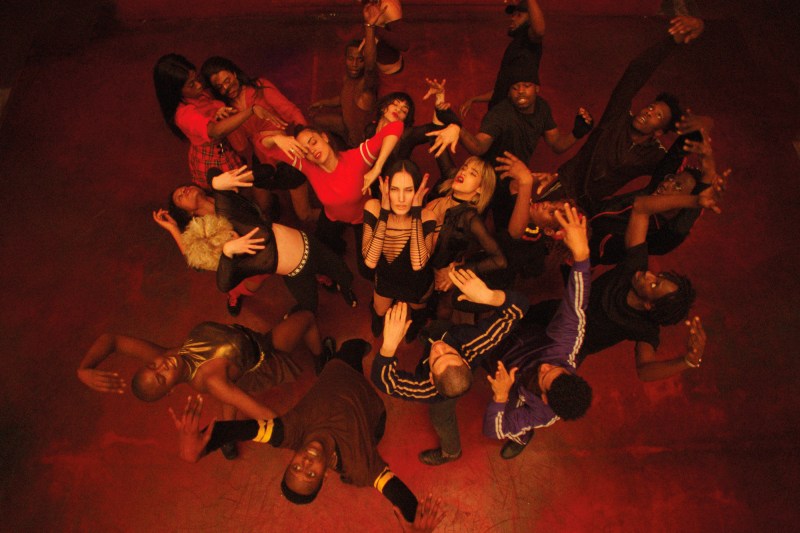“French dancers gather in a remote, empty school building to rehearse on a wintry night. The all-night celebration morphs into a hallucinatory nightmare when they learn their sangria is laced with LSD,” reads IMDB’s plot summary of French filmmaker Gaspar Noé’s latest cinematic creation, “Climax.”
What this plot summary, and any summary of the film will fail to capture, is the raw unchained energy that is unleashed throughout the entirety of the movie. Clocking in at a short 96 minutes and filmed in just 15 days, “Climax” is a work drenched in dynamic speed. It takes experimental cinema to a higher level, stretching it to new, though sometimes unbearable, heights.
Though the audience is unaware of it at the moment, the film opens with the final shot, a woman screaming with agony and writhing in the snow. Through title cards, we’re then told this story is loosely based on true events that occurred in France one winter in 1990. Each character is then introduced to us in a kind of interview video; we learn they’re all extremely devoted to dancing, as when one woman is asked what she would do if she could not dance, and she replies, “Suicide?”
What follows is a sharp dance number, all filmed in one shot, that lasts for minutes. There are at least 10 members in the dance troupe, all flying and snapping and darting across the screen. After this dance ends, the camera shot continues without cuts, transitioning seamlessly into the rehearsal’s after party. The dancers relax and chat, most of them drinking from a large batch of sangria.
We’re taken into multiple vignettes of conversations between the dancers, mostly revolving around sex and drama within the group. The entire film was improvised, aside from the dance choreography. Actors were occasionally told to scream more, be more mellow, or run around in circles, but otherwise, their lines were made up on the spot. This leads to the organic creation of both humorous lines like, “I’m not fake. You’re boring,” as well as chilling lines like, “It’s a nightmare. It’s a nightmare!”
We then move into a second act, if it can even be called that, as the camera shoots from above, focusing on a group dance circle. Some portion of the credits then appear, naming all of the musical artists featured in the film. This decision by Noé jumpstarts the viewer into the realization that the music has not stopped since the beginning of the film, and it will only stop for a few minutes about halfway through.
A mob mentality then erupts throughout the dance troupe as they attempt to locate the person who spiked the sangria with LSD. The complete and utter breakdown of sound, color and light that occurs for the rest of the film is almost contrary to the title. The whole experience of the movie throws the viewer into multiple apexes, luring them into false senses of security through moments of quiet. The actors seem to act normally, then throw the viewer into scenes of violence, hallucinations and sex.
Noé is thinking of his viewer constantly throughout the film, always providing them somewhere to look. “Climax” is tactile, daring the viewer to participate in a terrifying intimacy with the actors through close-up unstable camera shots. Brilliant colors partition scenes into entirely different worlds and moods. By drawing attention to sound and light and color, he installs distance between the viewer and the actors. It is difficult to garner empathy for these dancers as they experience total degradation of body and mind; a brother and sister pair attempt incest, a man suspected of the spiking is thrown into the freezing snow and a mother locks her child in an electrical closet supposedly to keep him safe. We spend such little time getting to know these characters and their motives, ambitions and desires that empathy is masked by slight disgust and sheer confusion. We understand the LSD is to blame, but to what extent? The question of who spiked the sangria, and when, and how, then becomes one of the least important issues of the film, and it is never fully addressed, leaving the viewer in a suspenseful and engaging limbo.
Ultimately, if Noé’s endeavor with this film was to completely immerse his viewer into total chaos, he was almost successful. One of the final scenes of “Climax” is an incredibly long shot, featuring total darkness (save a flashing red light) as the camera tracks the tumultuous movements of the dancers on the floor. This scene pulls the viewer out of that submerged madness because of its lack of cuts and little visibility; I was jolted out of the surreal reverie of the film as I struggled to actually physically see the scene. In a way, it may be viewed as a kind of “coming down” from the acid trip that the dancers experience, for in the following shots, the building is opened by what seem to be police officers to survey the anarchic damage.
To experience “Climax” is to experience a voyage into life and death, love and disgust, passion and sex, isolation and community; it is a journey into all of these elements simultaneously, and all in a stunningly confusing way that leans away from any meaning, but convinces the viewer no meaning is necessary.
Contact Marika Tron at mtron ‘at’ stanford.edu.
